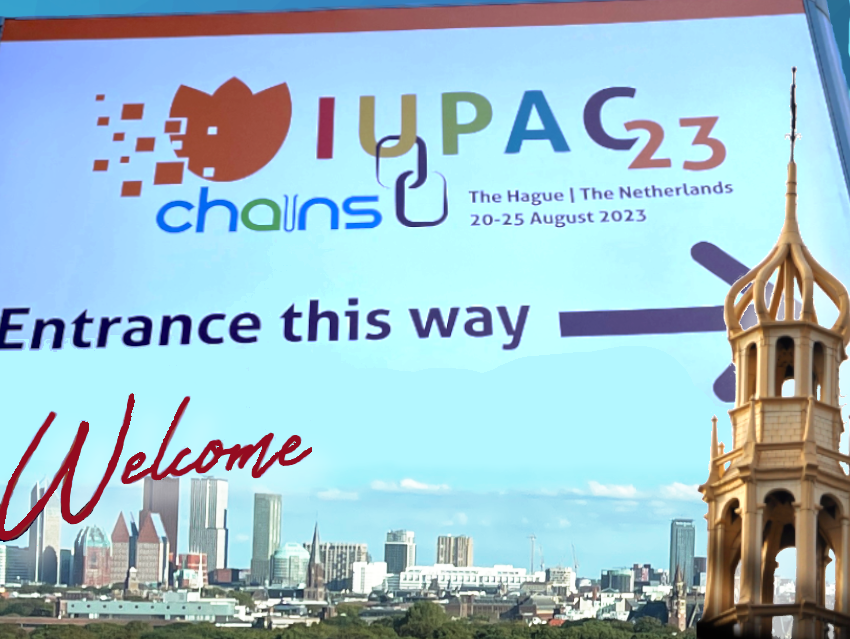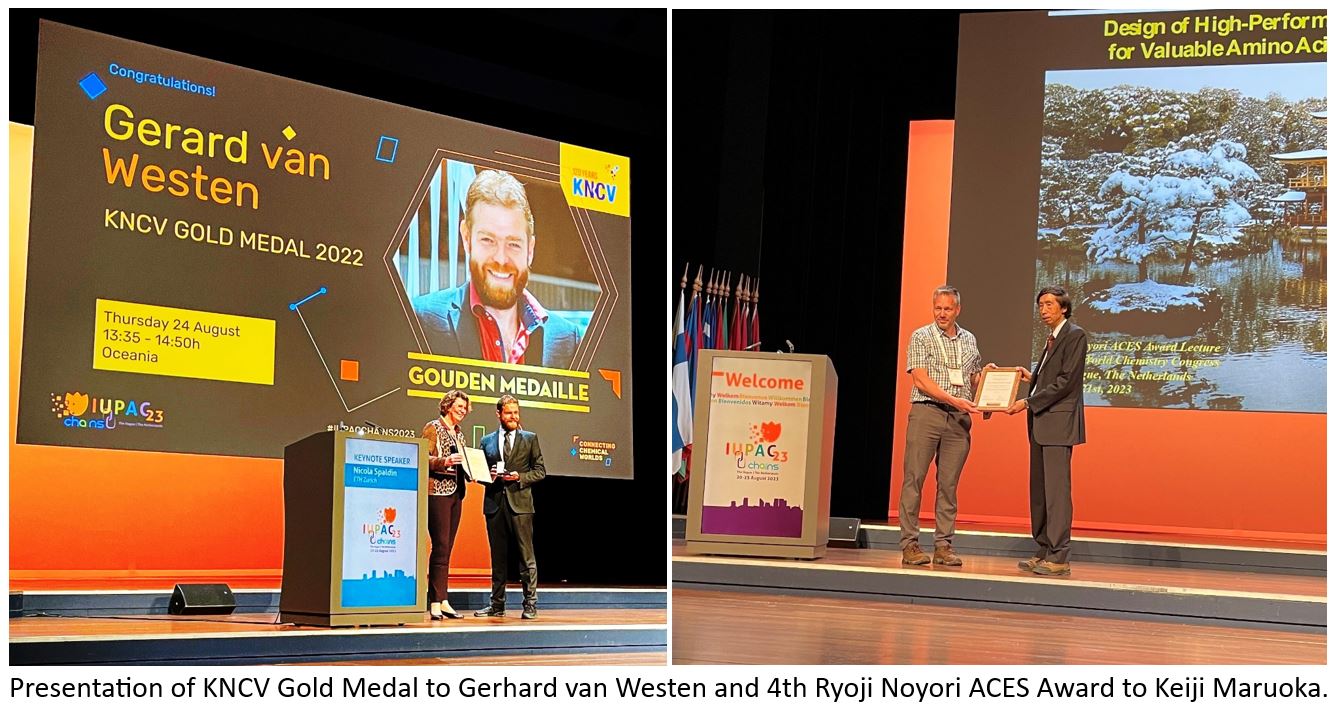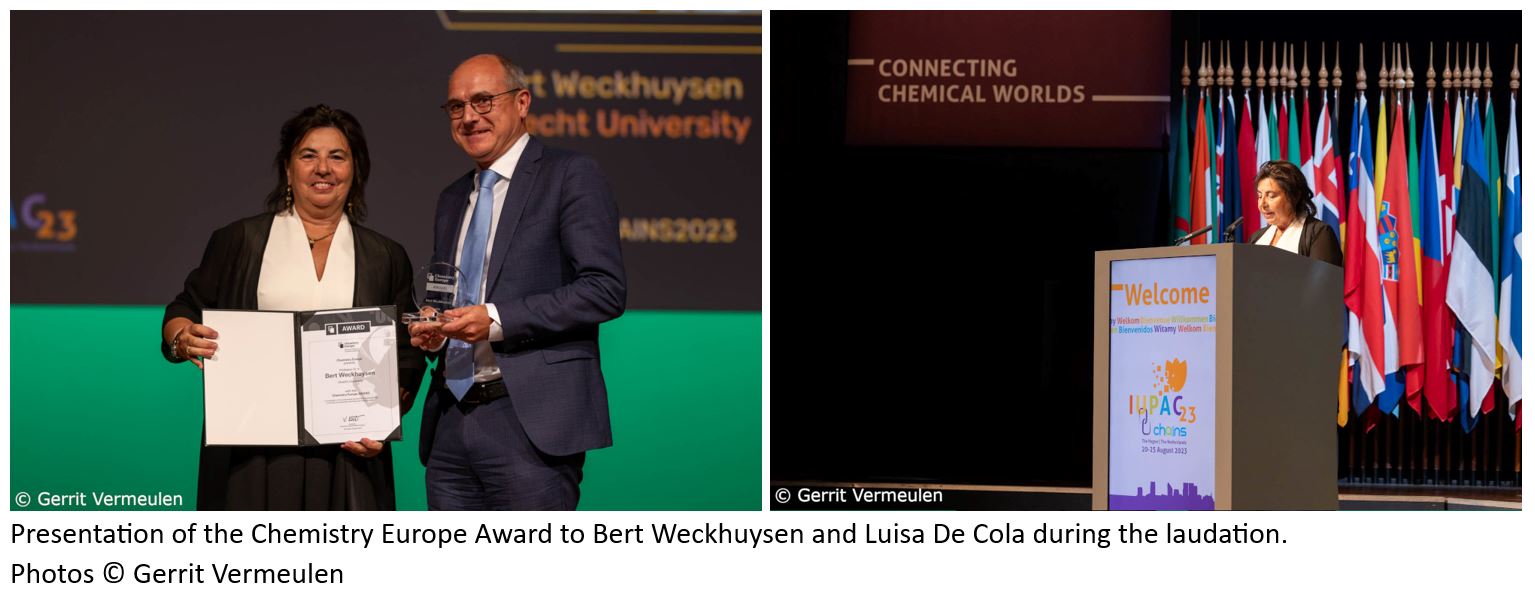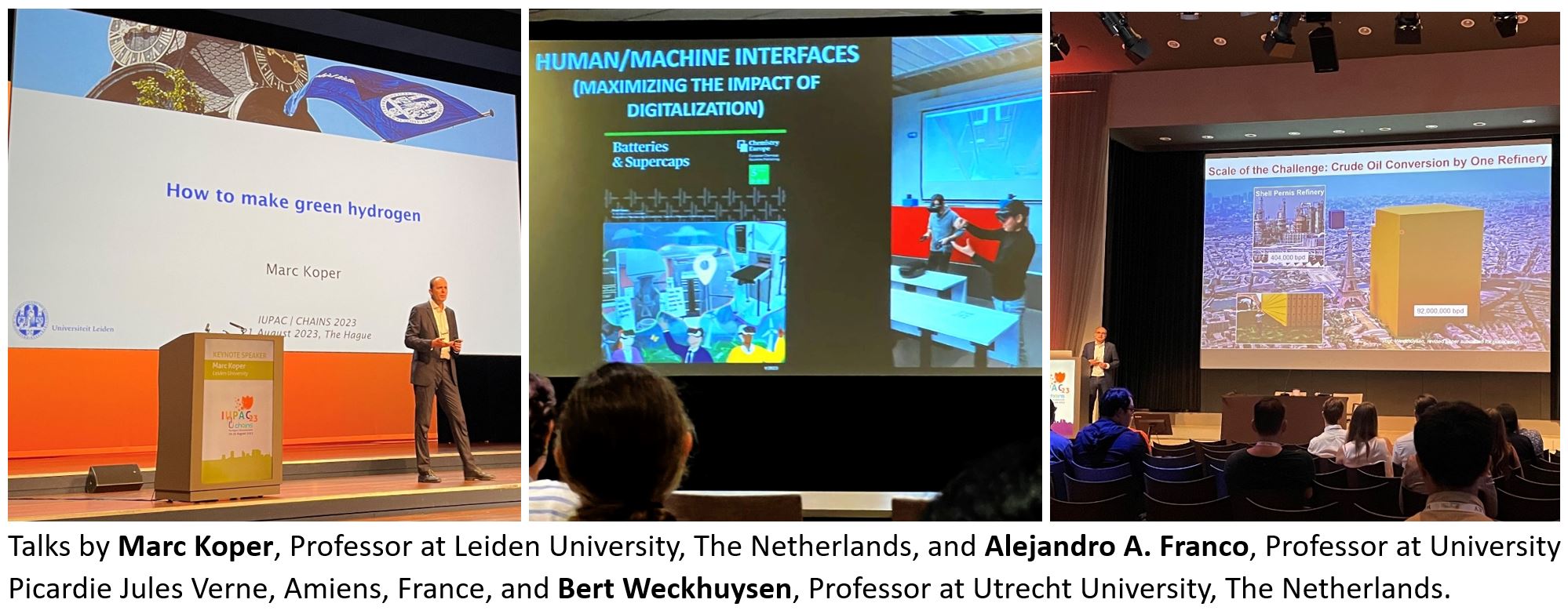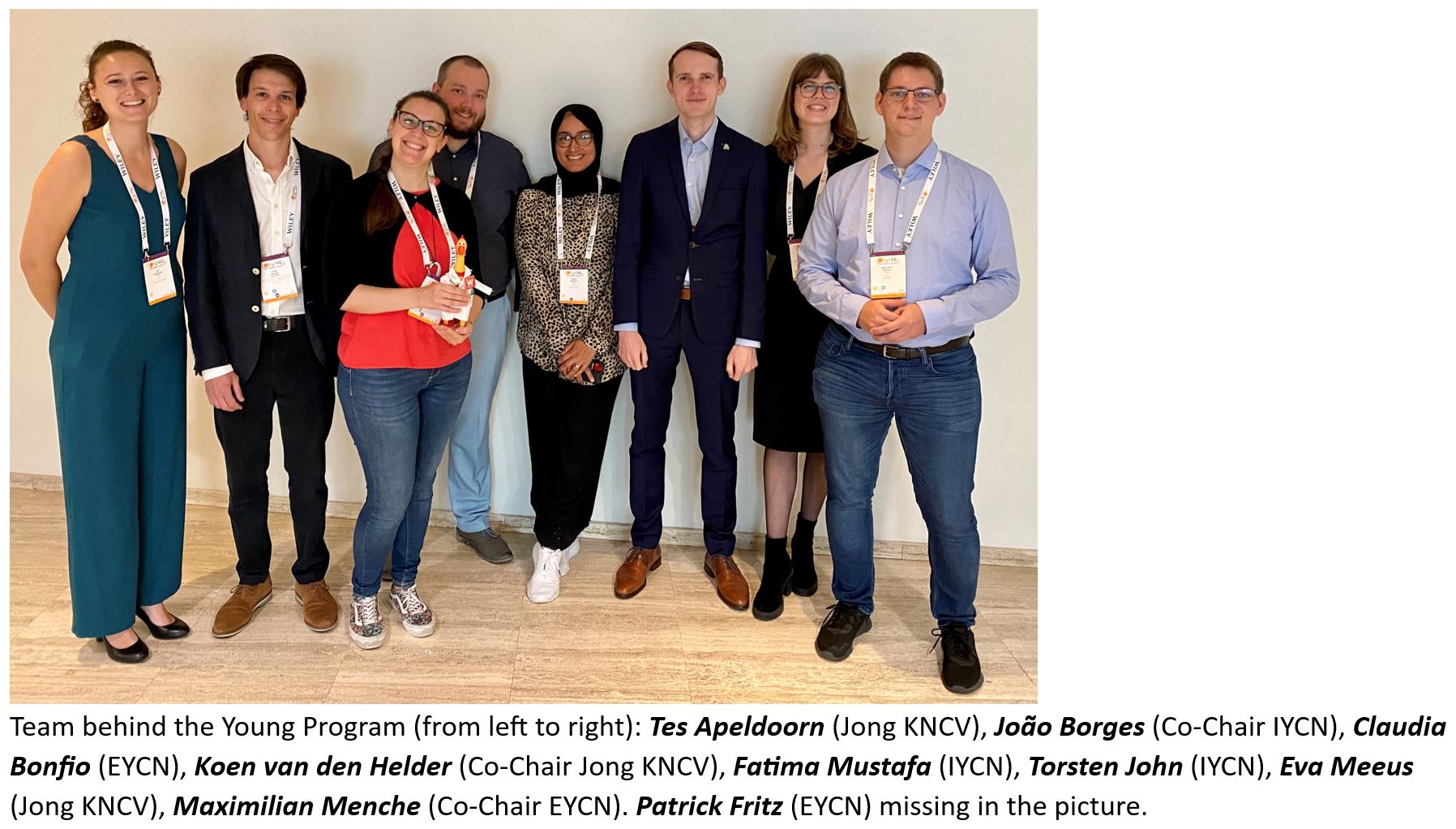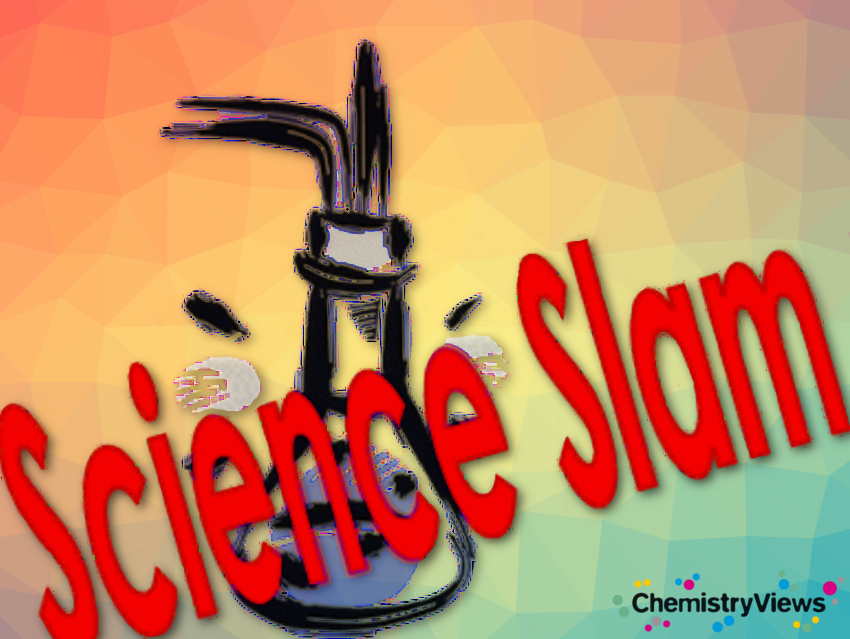The 49th World Chemistry Congress of the International Union of Pure and Applied Chemistry (IUPAC) together with the 11th CHAINS meeting, the annual chemistry congress of the Netherlands Research Council (NWO), was held in The Hague, The Netherlands, on August 20–25, 2023. Drawing participation from around 77 countries, the event served as a platform for approximately 2,000 attendees to foster idea exchange, cultivate new collaborations, and engage in discussions about the realm of chemistry.
For me, it has been an enriching week, filled with exciting encounters and new insights, and I fully agree with Javier García Martínez, President of IUPAC and Professor at Alicante University, Spain, who said during the opening ceremony: “Take every opportunity to talk to other colleagues and learn from areas that may be different from your own. In doing so, you will broaden your horizons and embrace the true beauty, complexity, and profound richness of chemistry.”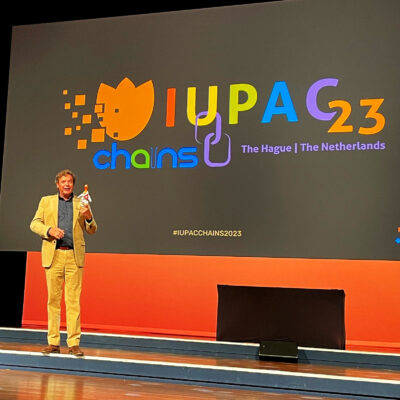
Besides many oral presentations and posters that covered various facets of chemistry, there were nine plenary talks, interactive panel discussions, an enthralling Young Chemists Program, and a social program that included, for example, a pub quiz and a visit to the Centre for Chemistry and Technology (ChemTech Centre) at the Organisation for the Prohibition of Chemical Weapons (OPCW).
The meeting was held at the World Forum, located in a pretty neighborhood of The Hague, amidst embassies and an international school, the International Criminal Tribunal for the former Yugoslavia (ICTY), the OPCW’s Headquarter, the European Union Agency for Law Enforcement Cooperation (Europol), the Kunstmuseum Den Haag, and a charming street with small stores and restaurants, all near the harbor and the famous Scheveningen beach.

1 Selected Talks
The event featured a comprehensive program of lectures covering the latest research findings and broader overviews. In addition, there was a so-called Young Program organized by the International Younger Chemists Network (IYCN) together with the European Young Chemists’ Network (EYCN) and the Jong KNCV|Young Royal Netherlands Chemical Society. “The Young Program provided plenty of fruitful and truly inspiring interactions, networking opportunities, and learning experiences, as well as insights into the diverse career paths a chemist can pursue,” said Dr. João Borges, Co-Chair of the Young Program, Past Chair of the IYCN, and Senior Researcher at University of Aveiro, Portugal.
In the following are three selected contributions from the huge program.
1.1 Materials Chemistry and the Shift Beyond the Silicon Age
From the Stone Age to the Bronze Age and to the Iron Age, every significant advancement in human civilization has been propelled by material developments. The Silicon Age we are familiar with, which is built on silicon-based microelectronic devices, is coming to an end. This poses a challenge: how do we maintain and improve our current way of life, which relies on various aspects like commerce, transportation, and communication linked to these devices?
As technology uses more and more energy worldwide, there is an urgent need for materials that can help reduce the energy used by microelectronic devices. A promising group of materials is called magnetoelectric multiferroics. These materials combine the contra-indicated func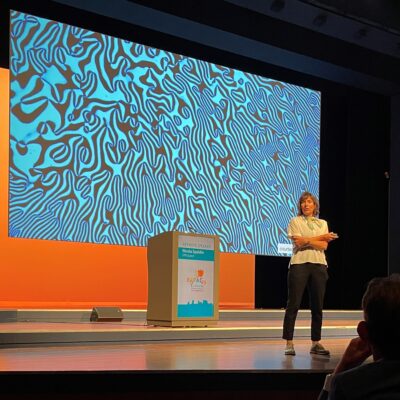 tionalities of ferromagnetism and ferroelectricity in the same phase. This allows for both storing and processing of information in the same component. Such materials could lead to new technologies that are lighter, smaller, and use less energy.
tionalities of ferromagnetism and ferroelectricity in the same phase. This allows for both storing and processing of information in the same component. Such materials could lead to new technologies that are lighter, smaller, and use less energy.
Nicola Spaldin, Professor at ETH Zurich, Switzerland, is using computer models and specialized facilities for the synthesis of multiferroics. Her first real success in developing a useful multiferroic material was the perovskite-structured oxide, bismuth ferrite, BiFeO3, which also is the most widely studied multiferroic. Applications of multiferroics range from catalysis (where, e.g., composite multiferroic CoFe2O4–BiFeO3 core–shell nanoparticles act as catalysts for the hydrogen evolution reaction (HER) [1]) to drug delivery and blue pigments (as seen in YInO3 doped with Mn to make YIn1−xMnxO3 [2]) offering enormous potential. Additionally, multiferroics can serve as model systems for the study of fundamental laws of nature.
1.2 Synthetic Chemistry Has Entered a New Era
Bartosz Grzybowski, Professor at the Institute for Basic Science, Daejeon, South Korea, vividly explained how computers are now entering the practice of synthetic chemistry. If properly programmed, modern computers could be designed to “remember” and process the entirety of chemistry. This concept envisions the creation of what he refers to as the “immortal scientist”. This machine could explore billions upon billions of potential syntheses in mere fractions of a second, subsequently selecting the one that is most economical, environmentally friendly, or involves the most readily available, commonly used chemicals [3].
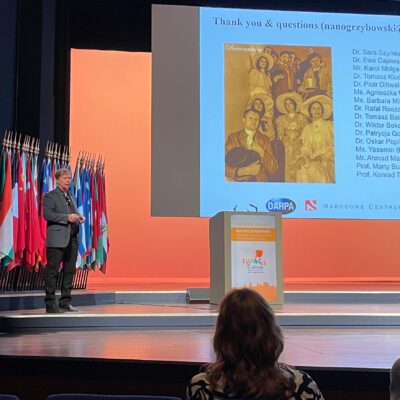 For decades, efforts in this direction have seen limited success. However, due to advancements in computing power and, more importantly, the development of new algorithms for encoding and manipulating synthetic knowledge across various levels, this capability is now within reach. Today, the complete autonomous planning of multi-step syntheses of complex (natural product) targets has become achievable. This includes the ability to unravel reaction mechanisms and uncover novel categories of reactions.
For decades, efforts in this direction have seen limited success. However, due to advancements in computing power and, more importantly, the development of new algorithms for encoding and manipulating synthetic knowledge across various levels, this capability is now within reach. Today, the complete autonomous planning of multi-step syntheses of complex (natural product) targets has become achievable. This includes the ability to unravel reaction mechanisms and uncover novel categories of reactions.
The Grzybowski group has developed the Chematica platform for retrosynthetic design [4]. At the core of this program, which has been built over a span of more than a decade, lies a knowledge base comprising approximately 75,000 reaction transforms/rules. Each transform was meticulously encoded by expert chemists, taking into account the fundamental reaction mechanism rather than just specific reaction examples. This approach also involves the precise delineation of substituent scope and contextual information, including potential reactivity conflicts, protection requirements, selectivity issues, and more. Chematica’s algorithms are trained to identify synthetic shortcuts that consolidate multiple reactions into a single step.
The group has also developed the Allchemy drug-discovery platform for discovering new synthetic methodologies and functional molecules [5,6]. Allchemy is a collection of around 10,000 generalized reaction transforms, each expertly encoded based on the underlying reaction mechanism. These reaction transforms encompass a wide range of robust reaction types commonly found in chemical industries, including pharmaceuticals, agrochemicals, as well as flavors and fragrances.
1.3 How to Stop the Spread of Misinformation
Misinformation is a problem of our time that can cause serious problems—even kill people and destroy democracies. In a very entertaining talk, Timothy Caulfield, Professor at the University of Alberta, Canada, explained that if done well, debunking misinformation works. Relating to recent studies, he explained how misinformation is spread, for example, through social media, celebrities, and ideology-driven agendas, and what strategies work well for individuals and organizations to fight back.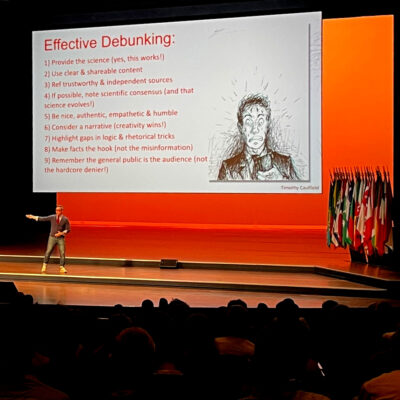
An absolute necessity is teaching critical thinking skills throughout life, starting from kindergarten. A good news is that you can reduce the spread of disinformation by up to 50 % if you tackle it from all angles: pre-bunk (letting people know misinformation exists), debunk, nudge (shows how other members of the community are behaving), and regulate (e.g., involving social media platforms). Getting individuals to pause even for a moment when they see information on their phones makes them less likely to believe and spread misinformation, Caulfield said. Another effective debunking technique is communicating with individuals about science outside your echo chamber, which can make a difference in stopping the spread of disinformation. Despite everything, scientists are still one of the most trusted voices. Use clear and sharable content to get your point across quickly without creating misunderstanding. Shareable content often includes visuals, charts, and concise text, which can be more engaging and appealing to your audience. This can lead to higher levels of engagement and interaction.
Reference trustworthy and independent sources. ScienceUpFirst is an initiative that works with independent scientists, researchers, health care experts, and science communicators to share the best available science in creative ways. You can follow them on social media (@ScienceUpFirst in English, and @LaSciencedAbord in French) or post with the hashtags #ScienceUpFirst and #LaSciencedAbord.
We as a scientific community should, wherever possible, note scientific consensus and that science evolves. The Institute for Ascertaining Scientific Consensus (IASC) is trying to do just that: get a sense of what the scientific consensus is, and then make it available to the media, policymakers, decision makers, and educators.
Another piece of advice is to be nice, authentic, empathetic, humble. It is really important to listen to the public, to get a sense of what their concerns are. It is so easy to get angry at people, but we need to figure out how to build bridges. This is not a miracle cure, but it can enable progress and later break down barriers that may exist.
Often it is a story, not necessarily evidence, that makes a difference. We can be creative, use humor or art to get our message across. We can highlight gaps in logic and rhetorical tricks and make facts, not the misinformation, the hook. Rather than focusing on the aspect related to the misinformation, focus on a common goal. For example, the fact that genetically modified organisms (GMOs) could help fight global hunger.
And last but not least, remember that the audience is the general public, not the hardcore denier.
2 Why We Need Everybody at the Science Party
IUPAC sees itself as a meeting place for chemists of all disciplines, of all ages, and from all over the world. A major concern that IUPAC’s president, Javier García Martínez, addressed at the conference is to question to what extent science is in danger of becoming a divider.
Science is becoming more expensive, more specialized equipment and facilities are needed, and access to publications and to the best talent is available only to a privileged few. This is not only deeply unfair, but it is also incredibly inefficient because the best minds, regardless of background, gender, and ethnicity cannot contribute to the discoveries of the future. “We need to make an extra effort to make sure that everybody, regardless of their background, gender, or ethnicity is invited to the same as party”.
For this reason, Javier García Martínez has invited, for the first time in more than 100 years, the Presidents of all the chemical societies (whether the society is part of IUPAC or not) together. The Presidents’ Forum is a new platform for sharing ideas and coordinating efforts so that chemical organizations can better contribute to building a brighter future for all.
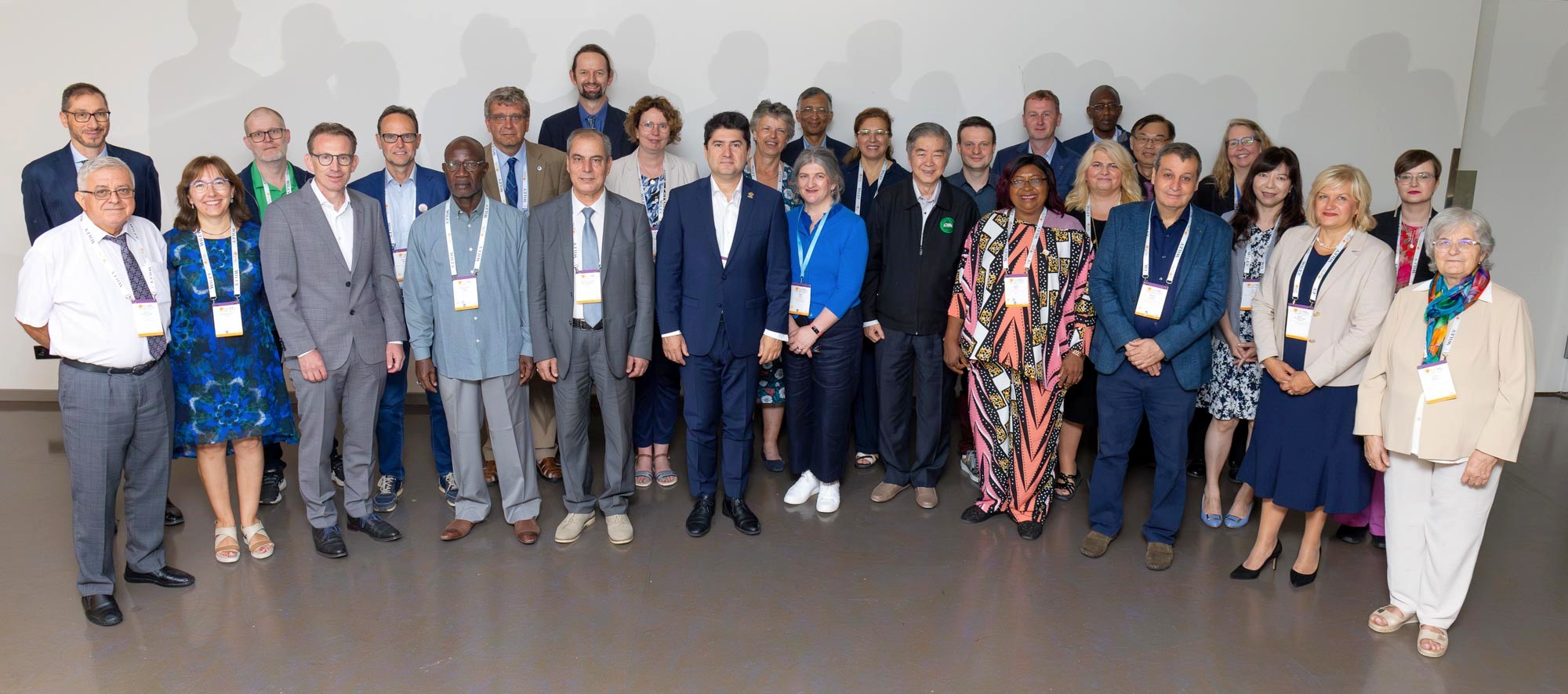 Group picture of presidents of all chemical societies at Presidents’ Forum.
Group picture of presidents of all chemical societies at Presidents’ Forum.
He reminded the listeners of the words of the UN Secretary-General, António Guterres, who stated last month that it was the hottest month ever recorded and mentioned that the era of climate change is transitioning into a new phase, stating that the era of global warming has concluded and the era of global boiling has begun. “We are running out of words to describe the consequences of our actions on the environment.”
However, Javier García Martínez is confident that the chemistry community can progress. “As mentioned earlier, chemists have a lot of superpowers, and we have yet another one: We know how to make bonds. This is our most important task, to forge new bonds, to create meaningful connections, and, thus, to unite the chemical worlds.”
AwardsAt the event, various awards were presented, among them the IUPAC Distinguished Women in Chemistry or Chemical Engineering prize which recognizes the contributions of female chemists and chemical engineers worldwide [A1]. Gerard van Westen, Professor of Artificial Intelligence & Medicinal Chemistry at Leiden University, The Netherlands, was awarded the KNCV Gouden Medaille, the most important scientific award in the Netherlands recognizing researchers under the age of 40. His primary research focus involves developing computational methods that can enhance, expand, and accelerate research into novel drugs, while also harnessing artificial intelligence and extensive public “big data” for precision medicine applications [A2]. Keiji Maruoka, Professor at Kyoto University, Japan, was awarded the highest honor offered by the Asian Chemical Editorial Society (ACES), the 4th Ryoji Noyori ACES Award [A3]. The award is named in honor of the Nobel laureate Ryoji Noyori, the founding Board Chair of Chemistry – An Asian Journal, the first ACES journal. Keiji Maruoka was honored at the Ryoji Noyori ACES Award Symposium for his innovative work on high-performance organocatalysts for selective organic synthesis, as well as his international research approach, which exemplifies the collaborative ACES spirit.
Bert Weckhuysen, Professor at Utrecht University, The Netherlands, is renowned as a pioneering and world-leading expert in researching heterogeneous catalysts. He was honored with the inaugural Chemistry Europe Award during the Opening Ceremony. The Chemistry Europe Award includes a prize money of 10,000 EUR and recognizes Bert Weckhuysen’s outstanding achievements and leadership in the field of sustainable chemistry and catalysis research [A4]. Luisa De Cola, Professor at the University of Milan, Italy, and Editor in Chief of the new open access flagship journal ChemistryEurope, gave the laudatio. Founded in 1995, Chemistry Europe publishes a family of high-quality scholarly chemistry journals, covering a very broad range of disciplines, as well as ChemistryViews. With this award, Chemistry Europe underscores its mission to support scientific excellence by chemical researchers, as well as scientists in their efforts to solve the challenges that affect humanity. The award is presented every two years and focuses on a specific topic each time. The theme for 2023 was Chemistry for Sustainability, Energy, Materials, Environment. The award is open to both members and non-members of Chemistry Europe societies from all nations [A5].
References[A1] IUPAC 2023 Distinguished Women in Chemistry or Chemical Engineering, ChemistryViews 2023. |
3 Gala Dinner
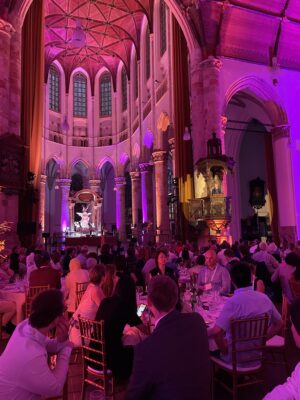 There were various evening events, such as a pub quiz, a chemistry party, and a gala dinner. The latter took place in the Grote Kerk (Great Church). The Grote Kerk is the city church of The Hague and one of the most important works of brick Gothic architecture in the Netherlands. Most of the royal family’s wedding and christening ceremonies were held in the church. Since the completion of a major renovation in 1987, the church has served as a venue for exhibitions, fairs, and festive events. Along with the Binnenhof, it is one of the oldest buildings in The Hague.
There were various evening events, such as a pub quiz, a chemistry party, and a gala dinner. The latter took place in the Grote Kerk (Great Church). The Grote Kerk is the city church of The Hague and one of the most important works of brick Gothic architecture in the Netherlands. Most of the royal family’s wedding and christening ceremonies were held in the church. Since the completion of a major renovation in 1987, the church has served as a venue for exhibitions, fairs, and festive events. Along with the Binnenhof, it is one of the oldest buildings in The Hague.
Robbert Dijkgraaf, Minister of Education, Culture, and Science of the Netherlands, and a theoretical physicist who served as the Director and Leon Levy Professor at the Institute for Advanced Study in Princeton, USA, from 2012 to 2022, said in his speech, “Chemists have remarkable abilities or superpowers: the power of imagination to envision a world yet to exist, a molecule waiting to be formed, a solution yet to be discovered; and our second power, fueled by curiosity, to test and ascertain the validity of those visions. This duality is incredibly important. The role science and chemistry plays in our current society is very large.”
4 Closing Ceremony
In 1928, the 9th IUPAC conference took place in The Hague, organized by Ernst Julius Cohen (1869 (Amsterdam) – 1944 (Auschwitz)), who was the third president of IUPAC. The IUPAC|CHAINS 2023 conference was concluded by Ben Feringa, Professor at the University of Groningen, The Netherlands, 2016 Nobel Laureate in Chemistry, and Honorary Chair of IUPAC|CHAINS 2023, using the same hammer that Ernst Julius Cohen used 95 years ago.
A few times Louis Pasteur was quoted during the Chemistry World Conference: “Science knows no country, because knowledge belongs to humanity, and is the torch which illuminated the world.” Floris Rutjes, Chair of the Local Organizing Committee, Professor at Radboud University Nijmegen, The Netherlands, and President of the European Chemical Society (EuChemS), expressed gratitude to all the volunteers and to everyone who contributed within this international community. The effort put forth is not solely for individual gain but rather a collaborative endeavor with the overarching goal of benefiting society at large.
“It’s been a remarkable journey since we pitched the bid to organize this event at the IUPAC Congress in Sao Paulo, Brazil, in 2017. The result has been a fantastic scientific congress that owes its existence to an incredible team, working tirelessly both upfront and behind the scenes. Together, they’ve truly showcased the incredible work of the chemical community”, says Jan-Willem Toering, Executive Director of the Royal Netherlands Chemical Society (KNCV).
5 Outlook
On January 1, 2024, Ehud Keinan, Professor Emeritus of Technion, Haifa, Israel, President of the Israel Chemical Society (ICS) since 2009, and Vice President and President-Elect of IUPAC, will become IUPAC President. He will take over from Javier García Martínez, who will become Past President and remain an officer and a member of the Executive Board for a period of two years.
Mary Garson, Professor Emeritus of University of Queensland, Australia, and creator of the IUPAC Global Women’s Breakfast Series, was elected IUPAC Vice President. The Vice President in 2024–2025 will become President of IUPAC for the 2026–2027 biennium.
The next IUPAC meeting, the 53nd IUPAC General Assembly and 50th IUPAC World Chemical Congress, will take place in Kuala Lumpur, Malaysia, from July 11 to 18, 2025. It will be organized together with Soon Ting-Kueh, President of the Institute Kimia Malaysia (IKM). The 2027 IUPAC world chemistry congress will take place in Montréal, Canada, from July 16 to 23, and the 2029 meeting will be held in Prague, Czech Republic.
Snapshots from the Conference
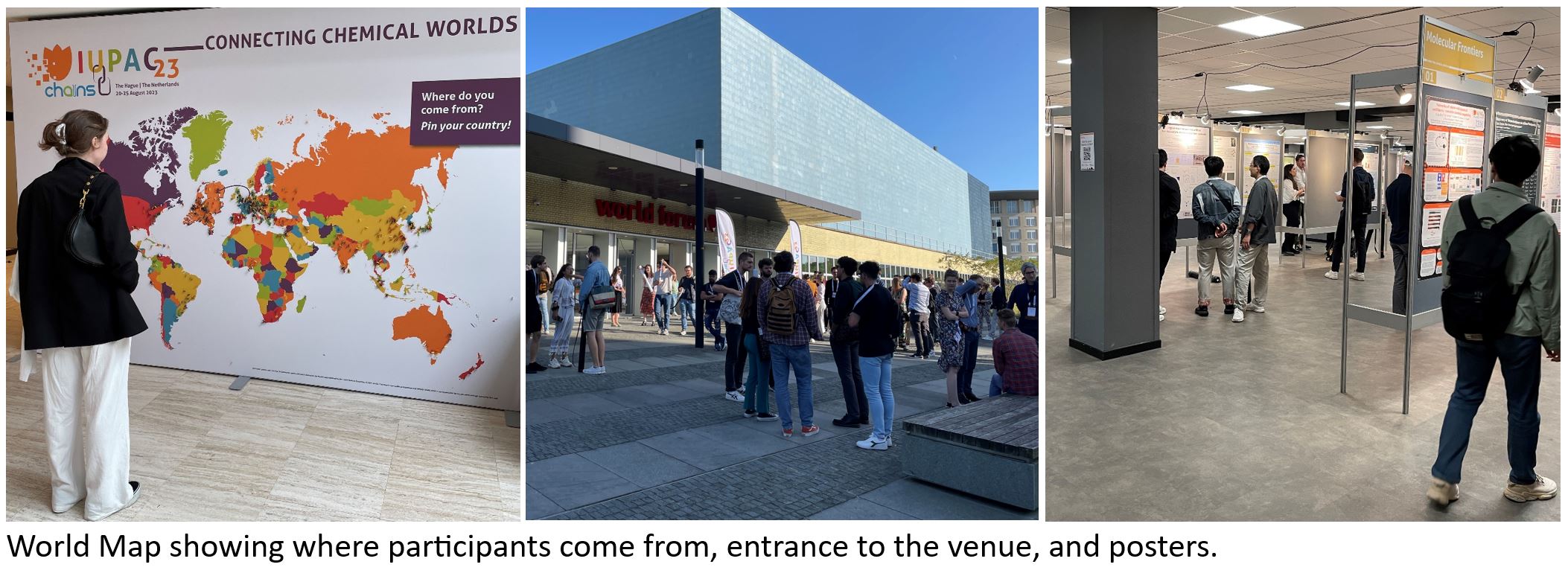
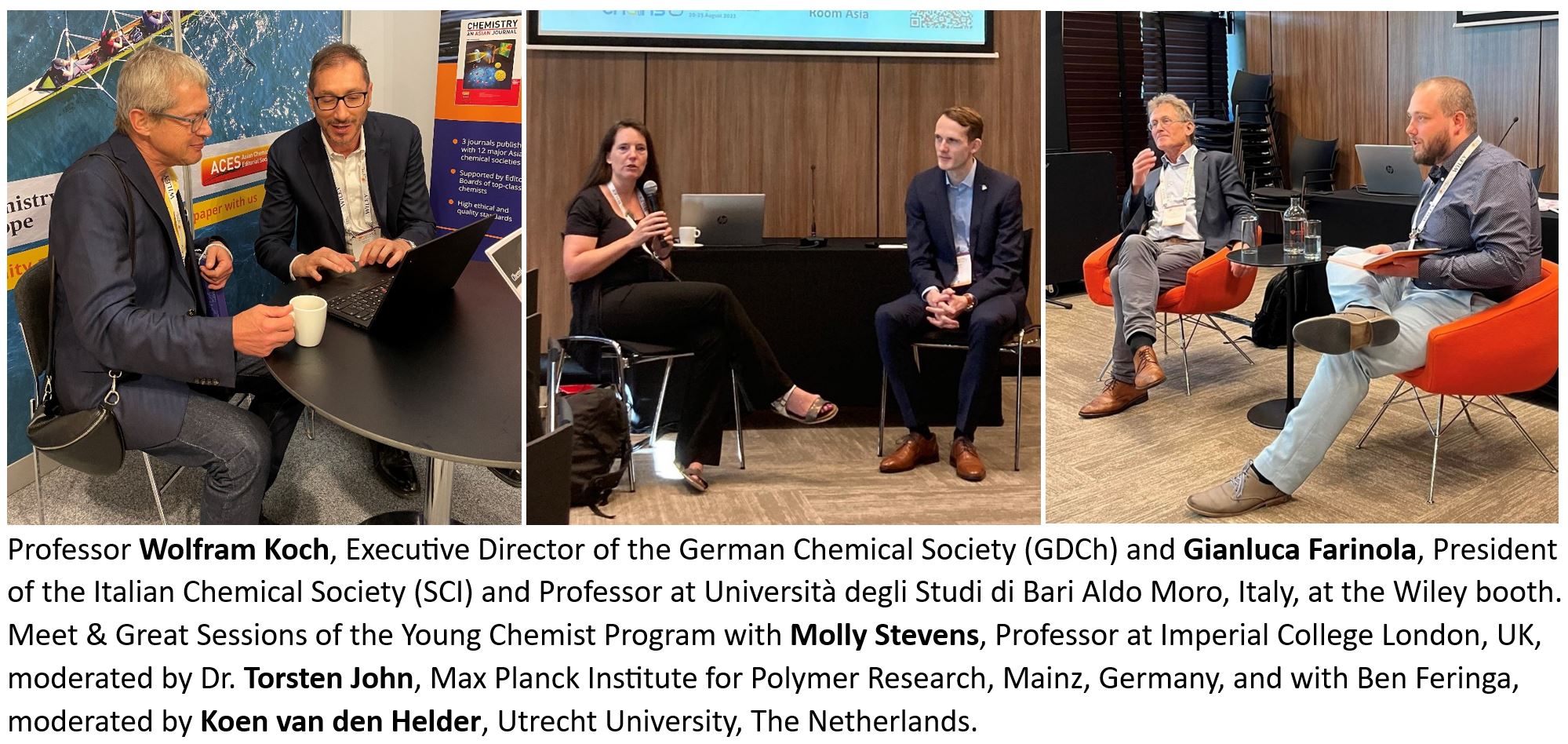
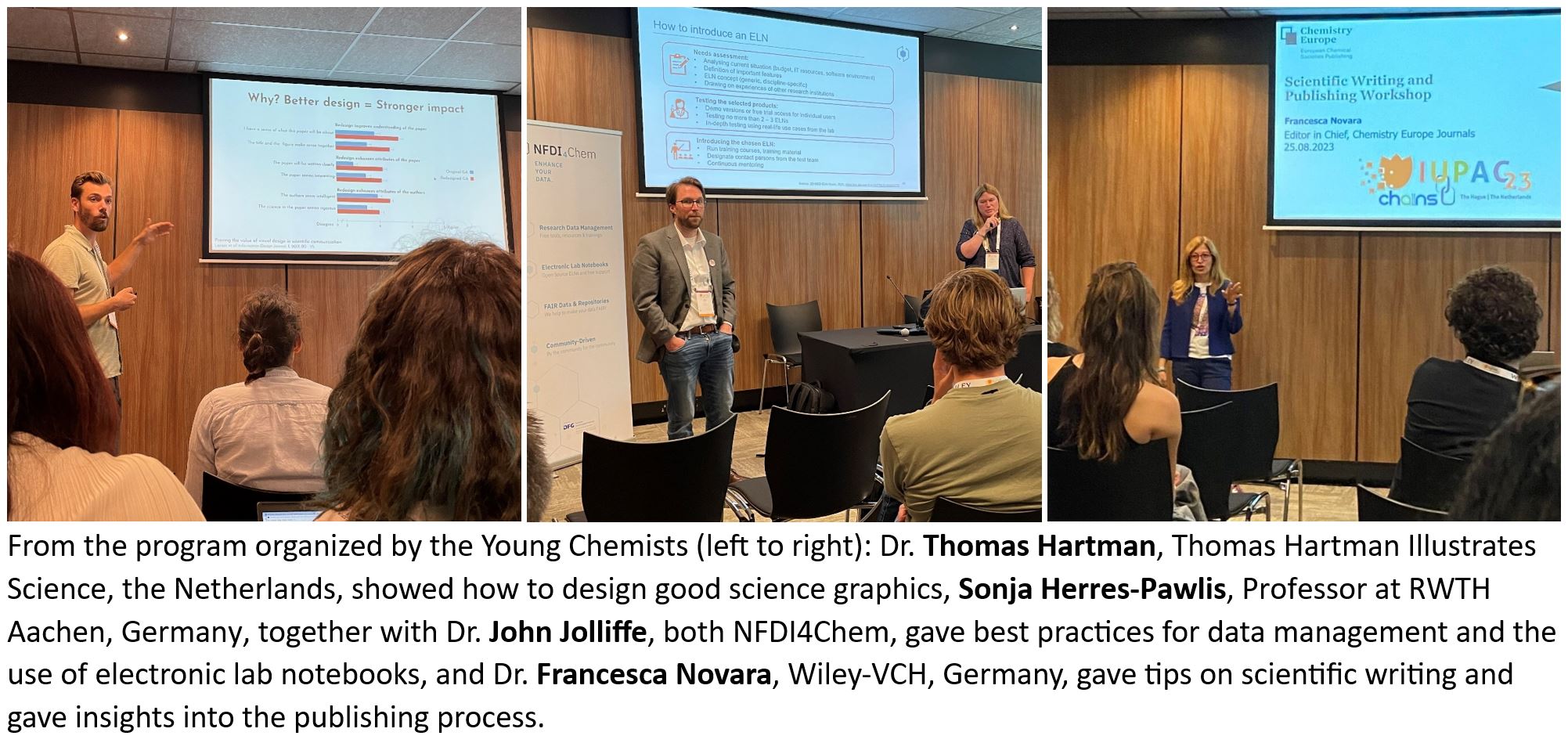
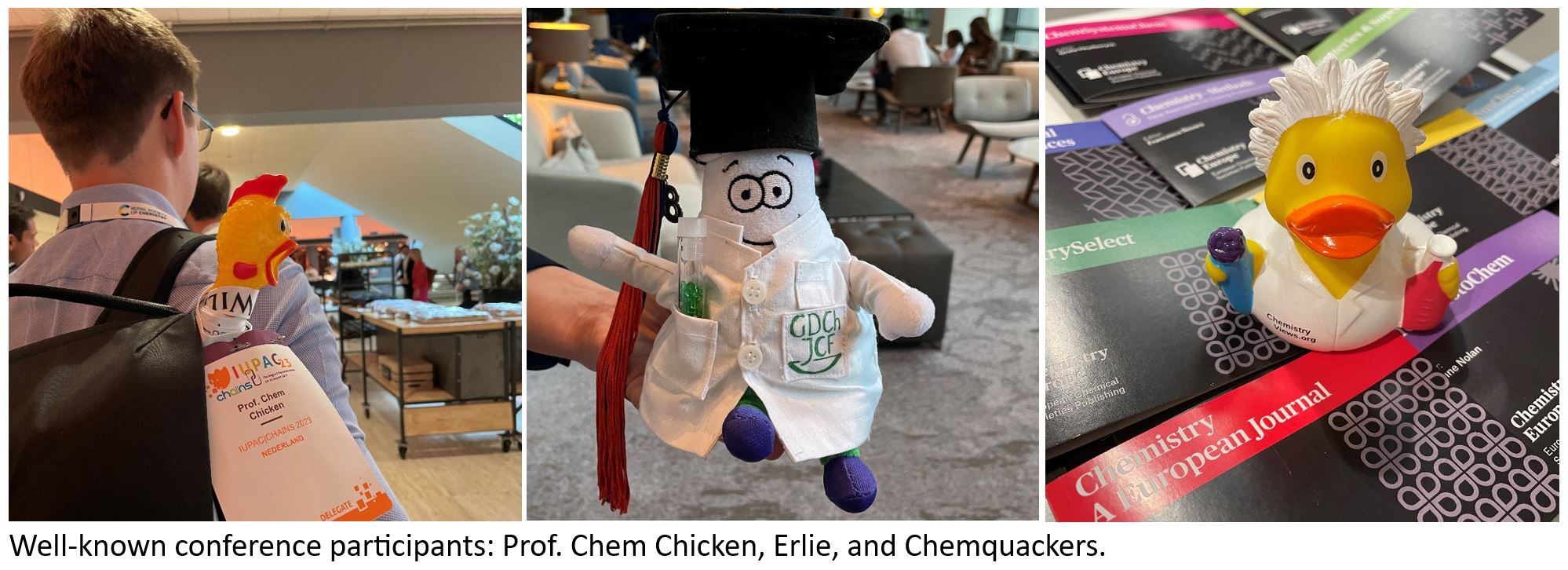
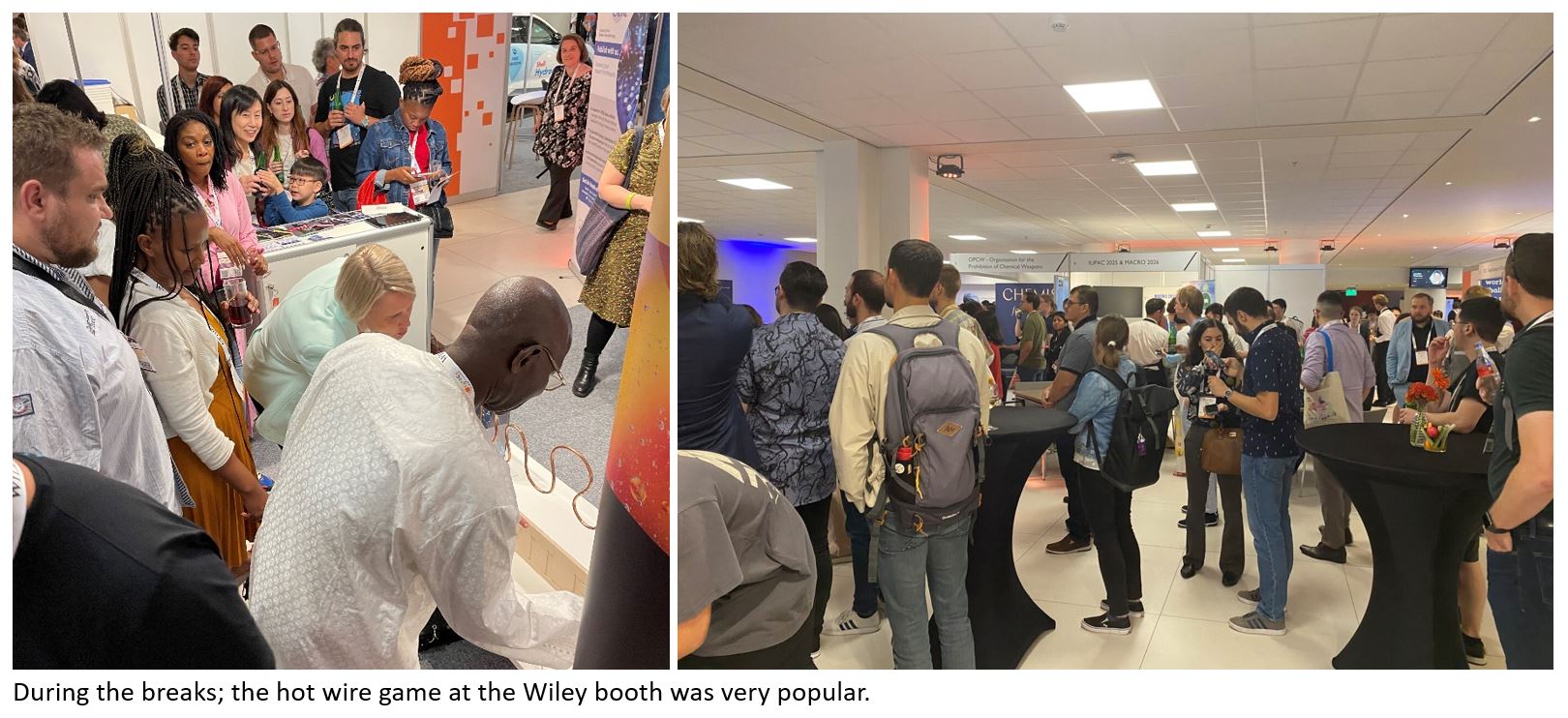
References
[1] Donghoon Kim, Ipek Efe, Harun Torlakcik, Anastasia Terzopoulou, Andrea Veciana, Erdem Siringil, Fajer Mushtaq, Carlos Franco, Denis von Arx, Semih Sevim, Josep Puigmartí-Luis, Bradley Nelson, Nicola A. Spaldin, Chiara Gattinoni, Xiang-Zhong Chen, Salvador Pané, Magnetoelectric Effect in Hydrogen Harvesting: Magnetic Field as a Trigger of Catalytic Reactions, Adv. Mater. 2022. https://doi.org/10.1002/adma.202110612
[2] Andrew E. Smith, Hiroshi Mizoguchi, Kris Delaney, Nicola A. Spaldin, Arthur W. Sleight, M. A. Subramanian, Mn3+ in Trigonal Bipyramidal Coordination: A New Blue Chromophore, J. Am. Chem. Soc. 2009, 131(47), 17084–17086. https://doi.org/10.1021/ja9080666
[3] Sara Szymkuć, Ewa P. Gajewska, Tomasz Klucznik, Karol Molga, Piotr Dittwald, Michał Startek, Michał Bajczyk, Bartosz A. Grzybowski, Computer-Assisted Synthetic Planning: The End of the Beginning, Angew. Chem. Int. Ed. 2016. https://doi.org/10.1002/anie.201506101
[4] Ewa P. Gajewska, Sara Szymkuć, Piotr Dittwald, Michał Startek, Oskar Popik, Jacek Mlynarski, Bartosz A. Grzybowski, Algorithmic Discovery of Tactical Combinations for Advanced Organic Syntheses, Chem 2019. https://doi.org/10.1016/j.chempr.2019.11.016
[5] A. Wołos, D. Koszelewski, R. Roszak, S. Szymkuć, M. Moskal, R. Ostaszewski, B. T. Herrera, J. M. Maier, G. Brezicki, J. Samuel, J. A. M. Lummiss, D. T. McQuade, L. Rogers, B. A. Grzybowski, Computer-designed repurposing of chemical wastes into drugs, Nature 2022, 604, 668–676. https://doi.org/10.1038/s41586-022-04503-9
[6] Barbara Mikulak-Klucznik, Patrycja Gołębiowska, Alison A. Bayly, Oskar Popik, Tomasz Klucznik, Sara Szymkuć, Ewa P. Gajewska, Piotr Dittwald, Olga Staszewska-Krajewska, Wiktor Beker, Tomasz Badowski, Karl A. Scheidt, Karol Molga, Jacek Mlynarski, Milan Mrksich, Bartosz A. Grzybowski, Computational planning of the synthesis of complex natural products, Nature 2020, 588, 83–88. https://doi.org/10.1038/s41586-020-2855-y
Also of Interest

B. Weckhuysen, Utrecht University and Chemistry Europe Award recipient, on catalysis, chemical community, and finding research topics

Award ceremony at IUPAC|CHAINS 2023 in The Hague, The Netherlands
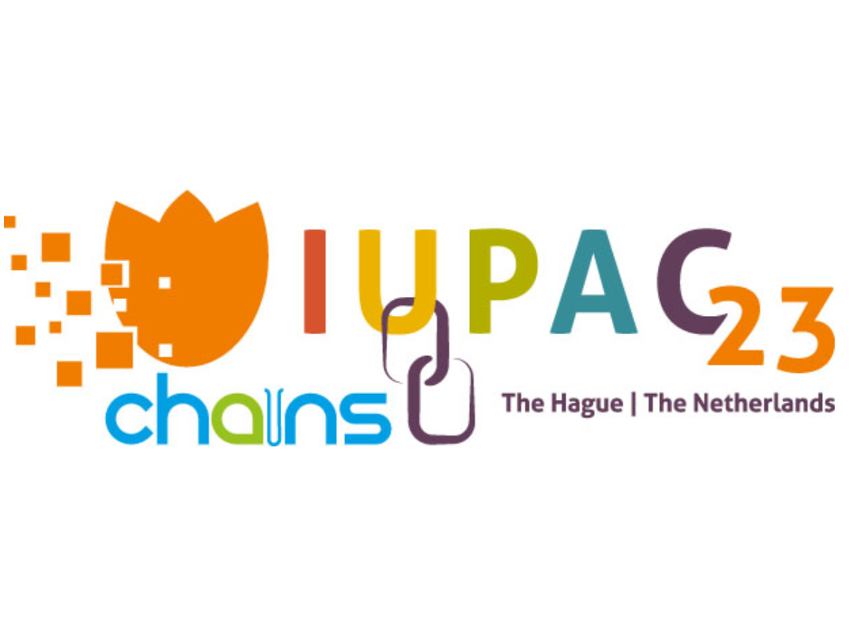
Brings together all disciplines of chemistry, a diverse audience of chemists from both academia and industry, and from all around the globe
Also check out C2W International‘s coverage related to IUPAC|CHAINS 2023 (it’s the membership magazine of the KNCV, the Royal Dutch Chemical Association)
- Poster prize winners
- The session on AI and scientific publishing
- Interview with keynote speaker Timothy Caulfield
- Interview with keynote speaker Chad Mirkin
- Interview with keynote speaker Marc Koper
- Interview with KNCV Gold Medal 2023 recipient Gerard van Westen
